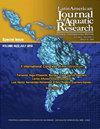下面是什么?通过eDNA分析揭示秘鲁Lobos de Afuera群岛的生物多样性
IF 0.8
4区 农林科学
Q3 FISHERIES
Latin American Journal of Aquatic Research
Pub Date : 2022-08-31
DOI:10.3856/vol50-issue4-fulltext-2782
引用次数: 0
摘要
环境DNA (Environmental DNA, eDNA)已成为评估不同环境下生物多样性的有力工具,可作为传统生物多样性评估方法的补充。我们在秘鲁Lobos de Afuera群岛(ILA)测试了eDNA作为评估海洋生物多样性的补充工具。使用商业eDNA试剂盒从ILA的三个地点收集了9个水样,然后使用针对12S rRNA基因的脊椎动物,硬骨鱼和海洋哺乳动物引物进行分析。在目、科、属和种水平分类的操作分类单位(OTUs)与通过目测方法获得的基线报告进行了比较。与传统方法相比,eDNA方法鉴定的物种数量减少了26%。然而,由于每个采样单位鉴定的硬骨鱼种类较多,因此这是一种具有成本效益的方法。eDNA分析提供了更高的分类水平(目、科和属)的更广泛的代表,对硬骨鱼的敏感性高于传统方法。此外,目视评估报告的相同数量的目和科被检测到eDNA。我们的研究显示了在偏远和偏远地区使用eDNA进行生物区系评估的实际意义。未来的工作应着眼于利用edna方法对难以到达的地方的生物多样性进行编目。本文章由计算机程序翻译,如有差异,请以英文原文为准。
What lies beneath? Revealing biodiversity through eDNA analysis in Lobos de Afuera Islands, Peru
Environmental DNA (eDNA) has become a powerful tool for assessing biodiversity in different environments and may be a complementary method compared to traditional methods to assess biodiversity. We tested eDNA as a complementary tool to assess marine biodiversity at Lobos de Afuera islands (ILA) in Peru. Nine water samples were collected from three sites within ILA using a commercial eDNA kit and then analyzed using vertebrate, teleost, and marine mammal primers targeting the 12S rRNA gene. Operational taxonomic units (OTUs) classified at order, family, genus, and species levels were compared to baseline reports obtained through visual survey methods. Compared with traditional methods, eDNA assays identified 26% fewer species. However, it was a cost-effective method due to the higher number of identified bony fish species per sampling unit. The eDNA assays provided a broader representation of higher taxonomic levels (order, family, and genus), with a higher sensitivity for bony fish than the traditional methods used. Also, the same numbers of orders and families reported by visual assessments were detected with eDNA. Our study shows practical implications for using eDNA for biota assessments in remote and isolated areas. Future efforts should aim to catalog the biodiversity from inaccessible places using eDNA-methods.
求助全文
通过发布文献求助,成功后即可免费获取论文全文。
去求助
来源期刊

Latin American Journal of Aquatic Research
FISHERIES-MARINE & FRESHWATER BIOLOGY
CiteScore
1.70
自引率
10.00%
发文量
44
审稿时长
4-8 weeks
期刊介绍:
Latin American Journal of Aquatic Research- LAJAR is the continuation of the journal Investigaciones Marinas (1970-2007) and is published since 2008 by the Escuela de Ciencias del Mar, Facultad de Ciencias del Mar y Geografía of the Pontificia Universidad Católica de Valparaíso. LAJAR is an “Open Access” journal that publishes in English language, original research articles, reviews and short communications on aquatic science, which contain the results of research conducted in aquaculture or in oceanic and coastal marine waters of Latin America.
The following topics are considered: Physical Oceanography, Chemical Oceanography, Marine Biogeochemistry, Marine Pollution and Toxicology, Marine Geology and Geophysics, Biological Oceanography, Fisheries and Aquaculture.
 求助内容:
求助内容: 应助结果提醒方式:
应助结果提醒方式:


